Technology

5 min
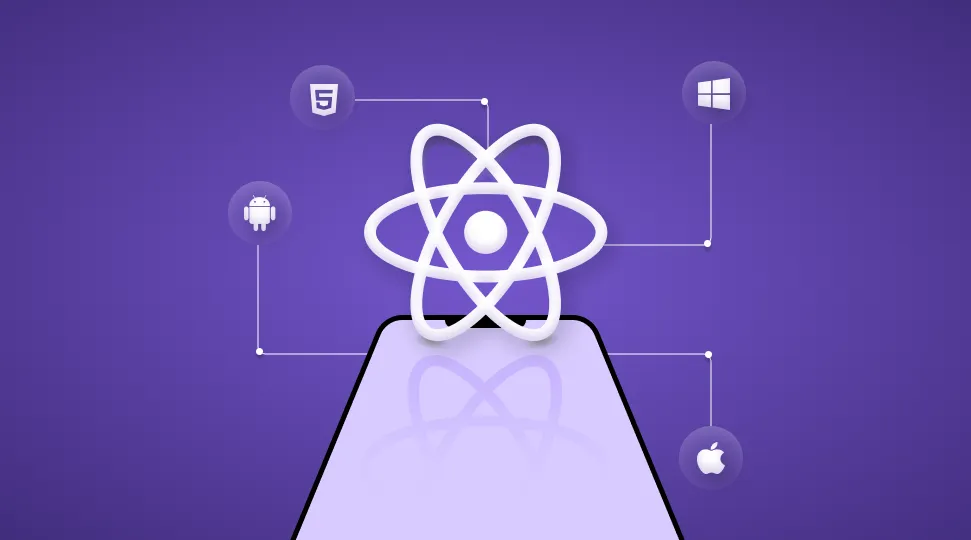
Discover how React Native development services revolutionize cross-platform app development, offering universal solutions for businesses. Explore the latest trends and advancements, including AI and AR integration, and learn about the market potential driving its growth. With insights into its advantages and real-world applications, find out why React Native is the go-to choice for startups and enterprises alike. Ready to elevate your digital presence? Dive into our comprehensive guide now!

By Ayushi Shrivastava
17 Apr, 2024
React Native is a tool of the Meta community and an addition to the cross-platform development world. It contains amazing resources, libraries, and functionalities to serve mobile apps to run on multiple platforms. React Native app development services leverage the business world objectives with universal apps. It has undoubtedly dominated the mobile app development industry with universal digital solutions.
Instead of brainstorming for different tech stacks, timelines, or release dates, React Native for cross-platforms is a modern approach. It has relieved developers from additional efforts and enabled businesses to focus on their core responsibilities. It accelerates the development time and product release in the given timeline for a broad audience. It is focused on the concept of code once and builds anything infusing the native-app-like capabilities without lacking performance and consistency.
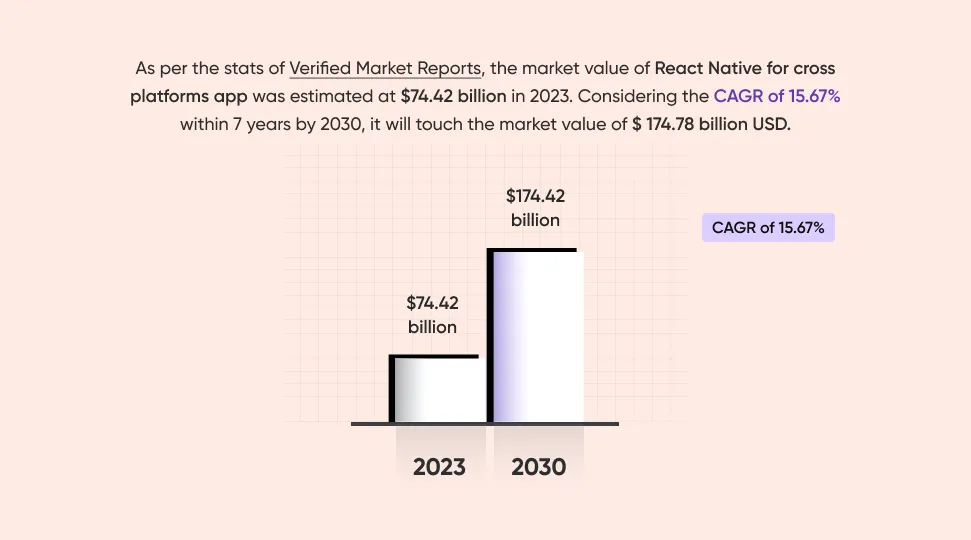
As per the stats of Verified Market Reports, the market value of React Native for cross-platform apps was estimated at $74.42 billion in 2023. Considering the CAGR of 15.67% within 7 years by 2030, it will touch the market value of $ 174.78 billion USD. React Native drives the momentum to cross-platform solutions without compromising performance and security. It can boost user engagement, conversion, app downloads, and revenue, minimizing the bounce rate.
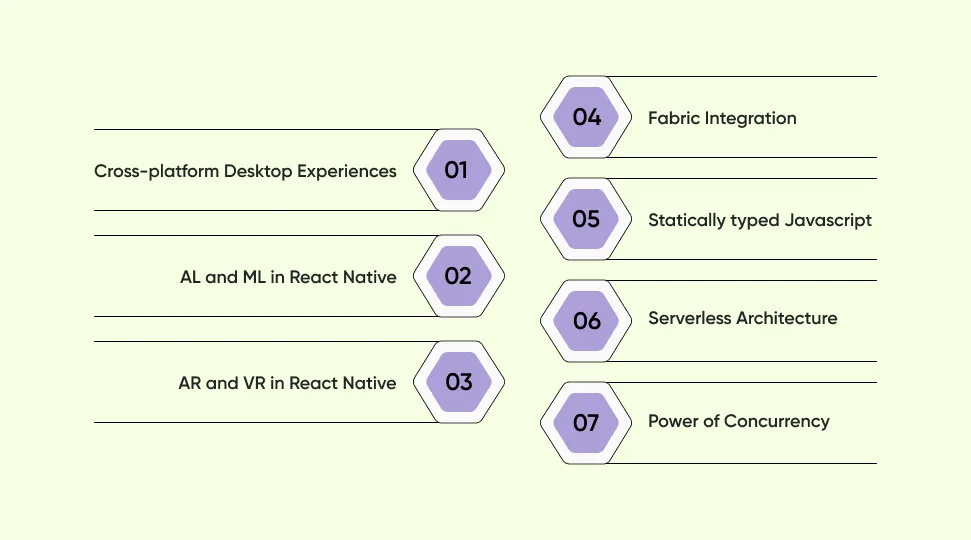 In 2023, developers were familiar with the Redux, Typescript, AI, and ML tools. In 2024, the community will adopt more AI, ML, and unique trends, driving advancement worldwide and strengthening the ground for cross-platform adoption of React Native app development services.
In 2023, developers were familiar with the Redux, Typescript, AI, and ML tools. In 2024, the community will adopt more AI, ML, and unique trends, driving advancement worldwide and strengthening the ground for cross-platform adoption of React Native app development services.
Explore the 7-gradient trend in React Native, which is revolutionizing the presence in the digital world.
React Native is not limited to mobile devices and OS; it will infringe on the desktop and tablets. It will also expand its reach to Windows, MacOS, and Linux OS. Developers will utilize React Native development to build amazing cross-platform solutions that accelerate performance, consistency, and scalability. They will fully utilize React Native for cross-platforms, leveraging libraries, plugins, component-based architectures, etc.
AI and ML were the talk of the development galore in 2024. The trend has been impressing developers with its charm for a decade. However, the non-IT business needed to familiarize itself with its significance. Now, AI and ML services advancements have anchored all the industry domains. Developers can build high-performance, robust, intuitive apps incorporating AI and ML capabilities. The tool kit and libraries can personalize digital experiences per user interest, adapting NLP and predictive analytics. Furthermore, it leverages image, object, and gesture recognition to deliver the user's best experiences.
AR and VR unlocked a new branch of opportunities, allowing developers to innovate and experiment. AR and VR development services are transforming the way of interaction in the real world, delivering immersive user experiences. In 2024, we can expect the emergence of tools to build cross-platform apps with AR and VR capabilities. It will also converge the native-like accessibility, abstracting the difference between the real world and the digital world.
Meta completely justifies the term ‘beyond’. Recently, it has stepped ahead, launching impressive and immersive tools and frameworks to develop it, giving the world a new vision. Fabric is another marvelous addition to the React Native community, revolutionizing strategies.
It has reduced the thread count, making programming practices more functional and adaptable. It accelerates the processes and performance of projects. It enables asynchronous rendering and prioritizes the user experience to carry forward the specific task users interact with. It has transformed the experience for users and cross-platform mobile app development services.
Typescript has gained an appreciation for static typing. It's a beautiful convergence of React Native and Typescript to accelerate the build of cross-platform solutions. Developers can use the JS syntax, redux libraries, and static typing of Typescript to drive the app's efficiency. It improves the readability and flexibility of the projects, eliminating potential errors. In 2024, more React Native tools and extensions will be launched in the market to support JS development.
This trend has taken center stage across all industries, including React Native. It has transformed the approaches to deployment and React Native mobile app development. Now, React Native developers are stepping towards the cloud ecosystem to avoid dependence on infrastructure, servers, and other resources. Firebase, Azure, AWS lambda, and AWS amplify Google Cloud Functions are the tools streamlining the development seamlessly. These are compatible to integrate with React native, offering databases, security authentication, and other native-like functionalities.
Rendering impacts the performance of most apps. We all know its frequently encountered scenarios. Thus, to tackle such scenarios, the concurrency mode will do wonders for React Native projects. It can manage multiple threads with responsiveness, delivering a seamless experience. In 2024, developers will see improvements in the same.
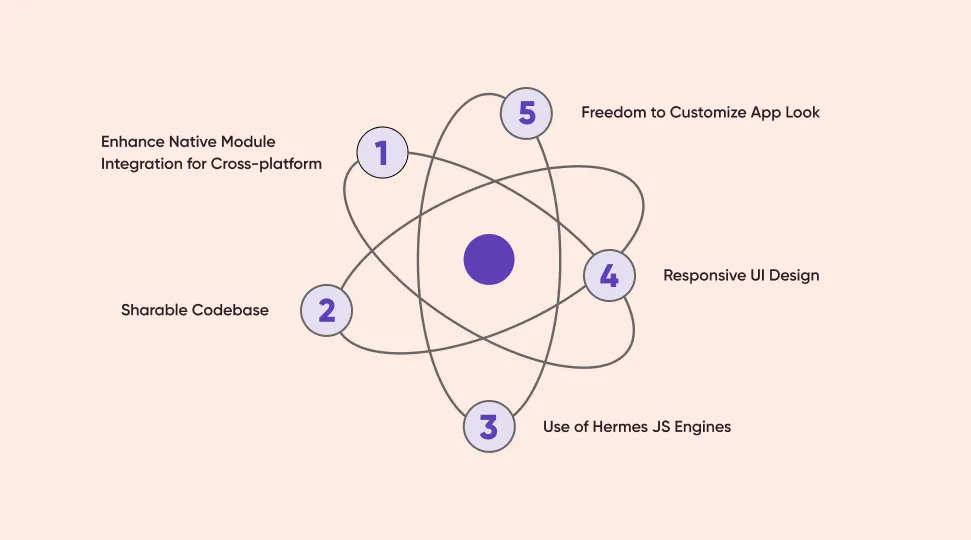 React Native is an adaptive, versatile JS framework that can easily adopt and incorporate new advanced capabilities. Get to know more reasons for React Native app development services for cross-platform solutions:
React Native is an adaptive, versatile JS framework that can easily adopt and incorporate new advanced capabilities. Get to know more reasons for React Native app development services for cross-platform solutions:
React Native has evolved with market dynamics over time. Developers have access to and support for native modules, libraries, and file extensions to integrate the essential capabilities. It allows for easy selection of features for specific OS/platforms. The availability of conditional logic, platform-specific modules, and tools enhances the app's functionality and appearance. Accessing heterogeneous settings enhances development productivity.
In React Native, developers can share codebases and logic across diverse platforms. This is crucial for managing the responsiveness and consistency of apps on different platforms. However, it’s simple to build cross-platform apps for businesses accessing React Native development services. With just 10% additional effort, developers can build smart apps. For this, they don’t need to pass platform-specific objects as references. It is simple to streamline the workflow, separating the business logic for modules and maintaining and updating functionality.
It has optimized the performance, efficiency, and productivity of React Native apps. It makes the app more functional and responsive, enabling faster rendering and reducing loading and memory consumption. Users can have native app-like experiences with seamless interactions.
React Native adapts a JS-based declarative syntax and component-based architecture. It drives the convenience of designing, developing, and debugging the app UI, creating separate components. With that, developers can tackle the states without compromising their appearance and functionality.
The React Native development team can customize the app appearance of their choice. They can access an array of styling tools and foundational component objects. The stylesheet API and style prop enable the developers to personalize the app style. It is possible to override and modify the existing styles. They can craft eye-catching UIs by merging animations, 3D elements, gestures, and navigations for different events.
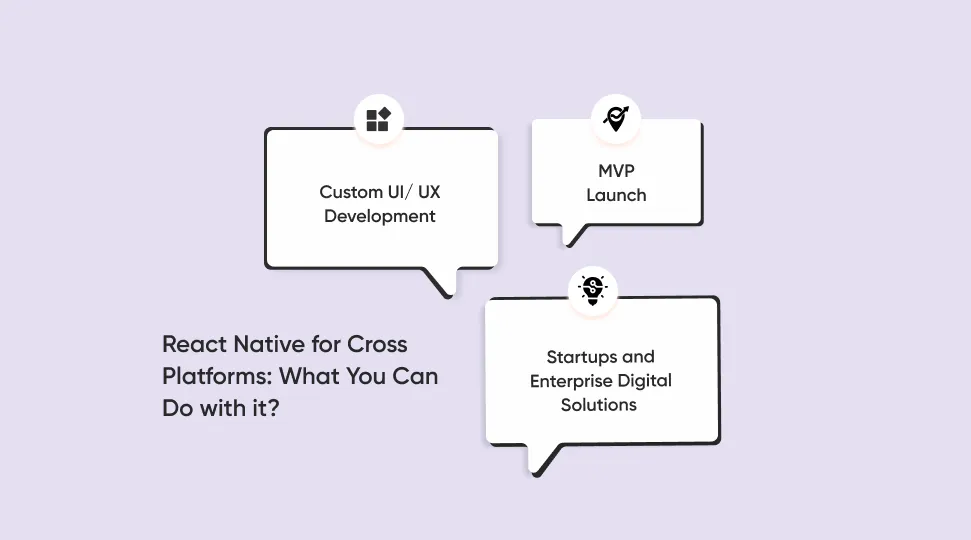
React Native is a free, open-source, multichannel platform that doesn’t need to deploy the code for different OS, including Mobile, desktop, and Linux. All the experienced React Native developers upvoted to deliver exceptional digital experiences.
Below are the applications of React Native development for cross platforms impressing the community and users.
As we have said, MVP products get upgraded after a while, and the developers' team is already engaged with the ongoing process. To empower startups and be ahead of competitors, React Native contains reusable components, libraries, and plugins. It enables scaling up the app features and functionality and developing a responsive and straightforward UI/UX design with the perfect solutions.
A React Native app development company can support the business in launching MVP products faster. They can build the optimal digital solution relevant to users' needs before their competitors on a limited budget. It is easy to customize and modify the features in real time without refreshing the action with the independence of multiple iterations.
In this digital world, React Native needs to reach potential customers who represent the business. Developers and businesses prioritize this tool for its efficiency, scalability, and reliability. It offers ease of development with a unified codebase to launch apps faster, meeting market demands.
Any business needing help modifying its operations aligns with the challenges of global marketplaces. React Native is an ideal choice in this industry.
The list includes Discord, Google, Salesforce, Meta, and Netflix. All have incorporated React Native app development services to develop digital cross-platform products. React Native is a future-driven tool that empowers startups and big names in the industry. It offers the best development environment with rich libraries, functionality, and third-party plugins. It rectifies the most common development issues like time, cost, and development efforts.
Want to grow and expand the revenue with higher conversions?
Stop hustling with global marketplace issues. Hire highly experienced React Native Developers from Quokka Labs to build futuristic apps that incorporate evolving trends. Engage cross-platform users, boosting the efficiency of your business operations.
Ans: React Native speeds up development by allowing platform code reuse, providing native-like performance. It enhances user engagement and satisfaction with consistent experiences, minimizing bounce rates and maximizing conversions.
Ans: React Native optimizes app performance through features like Fabric integration, statically typed JavaScript, and the Hermes JavaScript engine. These features improve rendering speed, reduce loading times, and enhance memory consumption.
Ans: React Native optimizes app performance through features like Fabric integration, statically typed JavaScript, and the Hermes JavaScript engine. These features improve rendering speed, reduce loading times, and enhance memory consumption.
Ans: React Native is a versatile tool enriched with platform-specific capabilities. Thus, developers can build cross-platform apps that function on diverse OSs. For any device or platform, React Native offers a seamless development workflow.
Ans: React Native leverages platform-specific file extensions and improved support for tools like CocoaPods on iOS to integrate native modules seamlessly into applications. Additionally, it provides tools like Platform.OS and Platform.Version for platform-specific logic.
Ans. A cross-platform app development platform is a software framework or toolset that enables developers to create mobile applications that can run on multiple operating systems, such as iOS, Android, and sometimes even web browsers, using a single codebase. These platforms typically offer a variety of features and tools to streamline the development process, allowing developers to write code once and deploy it across different platforms.
Ans. When evaluating the best cross-platform development options, React Native often stands out as a compelling choice. Its robust framework, backed by Facebook, empowers developers to build high-performance mobile applications using JavaScript and React. React Native facilitates code reuse across platforms, expediting the development process while ensuring native-like user experiences.
Top 11 Must-Have Features of a Custom Web Application in 2026
By Dhruv Joshi
5 min read
Generative AI Tech Stacks: Choosing the Right Tools for Scalable AI Development
By Dhruv Joshi
5 min read
Choosing Best Tech Stack for Web App Development: Performance, Cost, and Scalability
By Dhruv Joshi
5 min read
Top 9 Tech Stacks for Scalable Web Application Development
By Dhruv Joshi
5 min read

Technology

7 min
Generative AI is moving fast into enterprises, from banks to hospitals to government agencies. Adoption is rapid, but security planning lags. Unlike traditional systems, these models can be exploited through prompt injection, poisoned data, or manipulated to leak sensitive information. They are also misused for phishing, deepfakes, and malicious code.


Technology

7 min
AI-powered Web Application Firewalls (WAFs) go beyond static rules by using machine learning, anomaly detection, and predictive analysis to block zero-day threats, reduce false positives, and protect APIs at scale. Unlike traditional WAFs, they self-learn, adapt in real time, and cut operational costs while improving compliance and trust.


Technology

5 min
AI is redefining mobile app security by transforming how threats are detected, tested, and prevented. From continuous monitoring and fraud detection to compliance with regulations, AI ensures apps remain resilient against modern risks. This means safer apps, protected users, and stronger businesses. Investing in AI-driven security today builds trust, drives growth, and secures long-term competitive advantage.


Feeling lost!! Book a slot and get answers to all your industry-relevant doubts